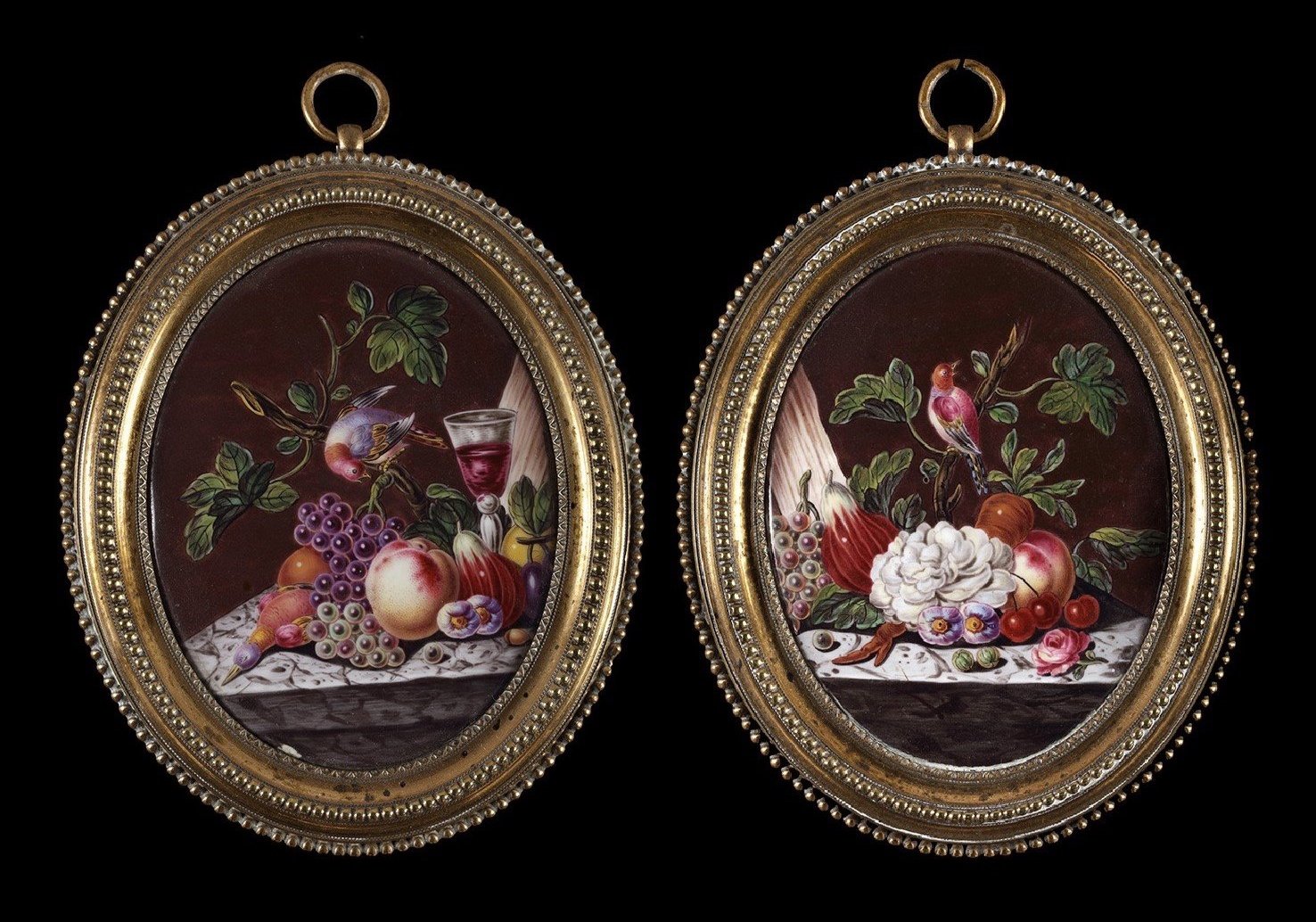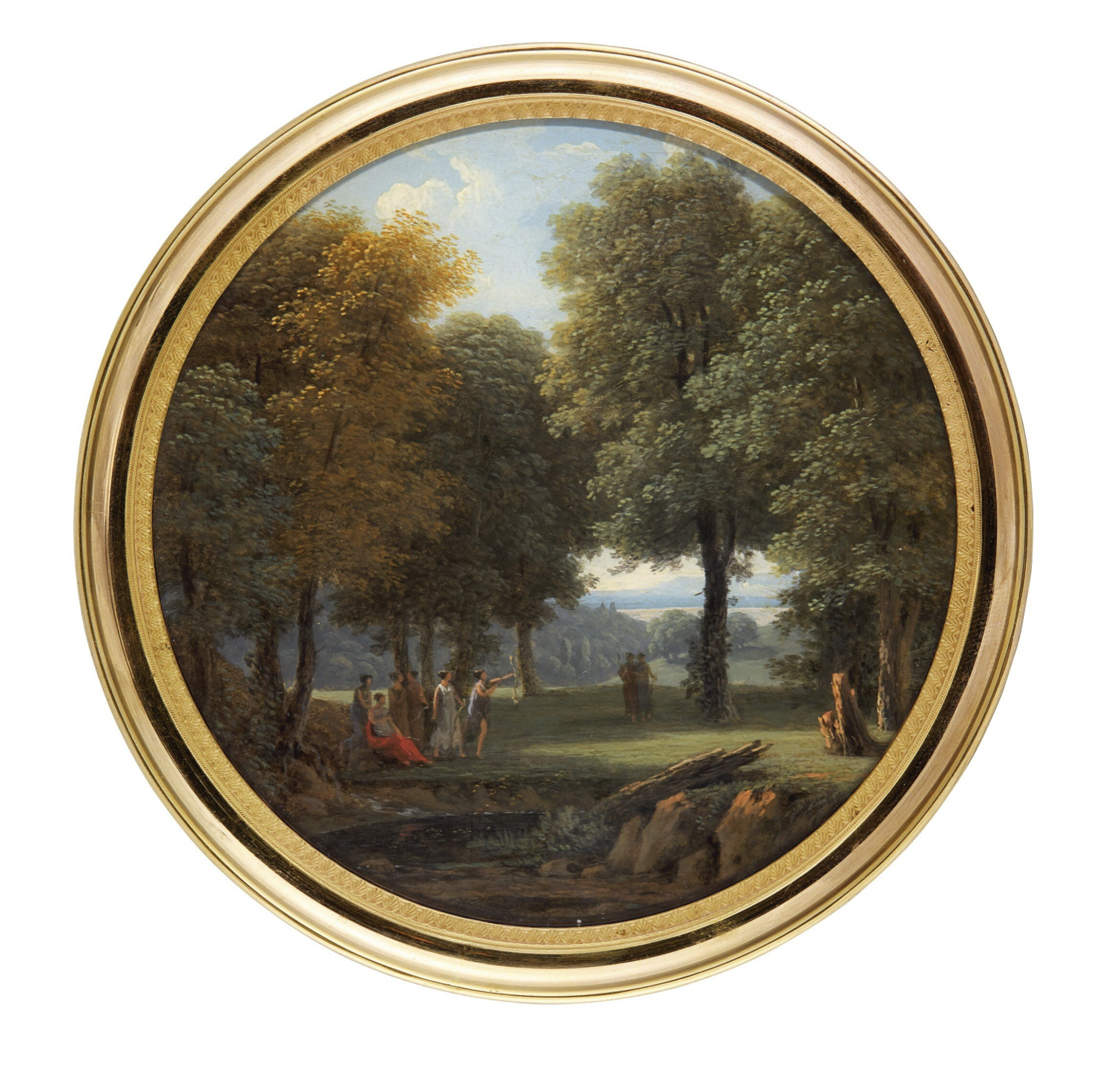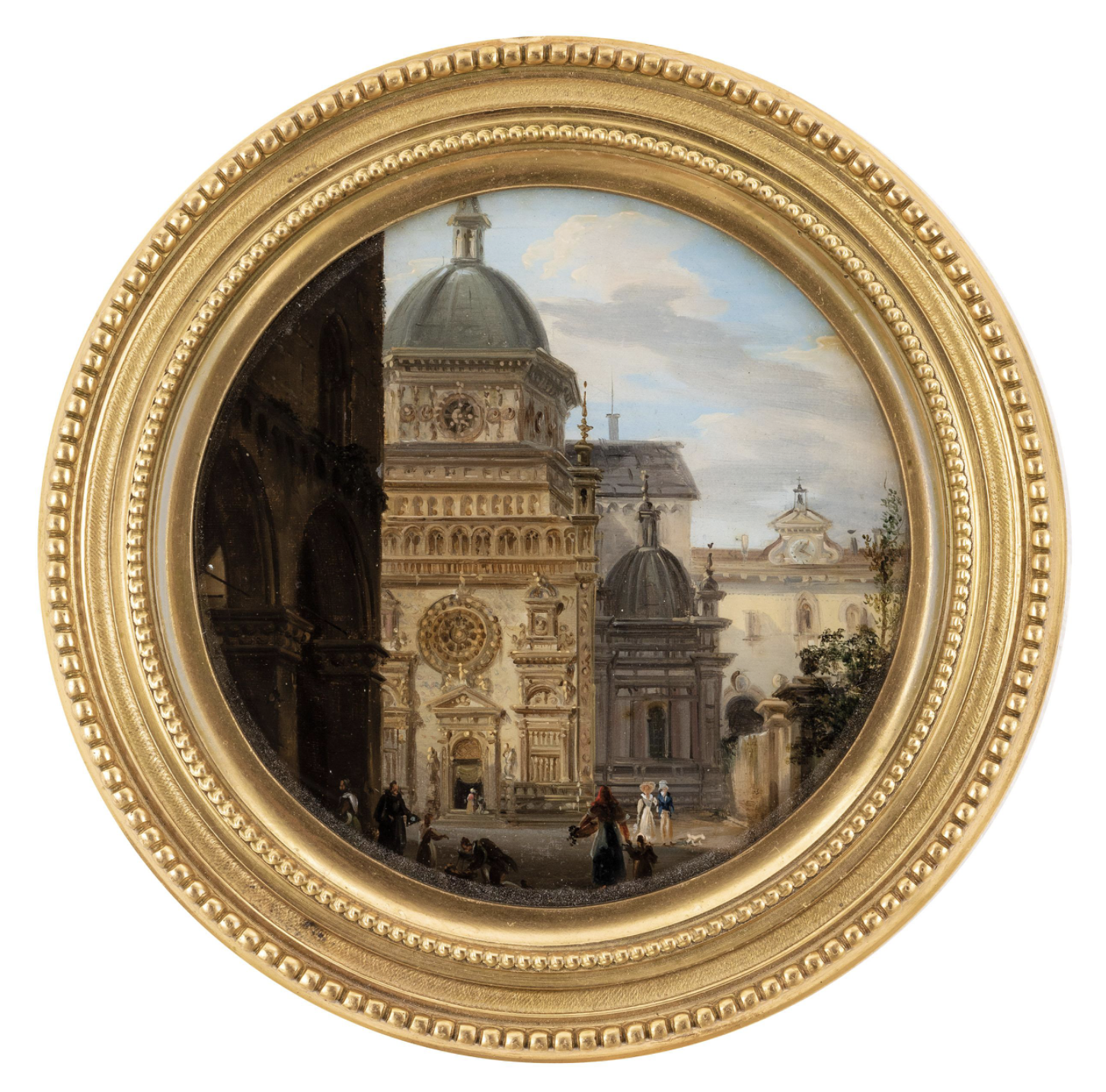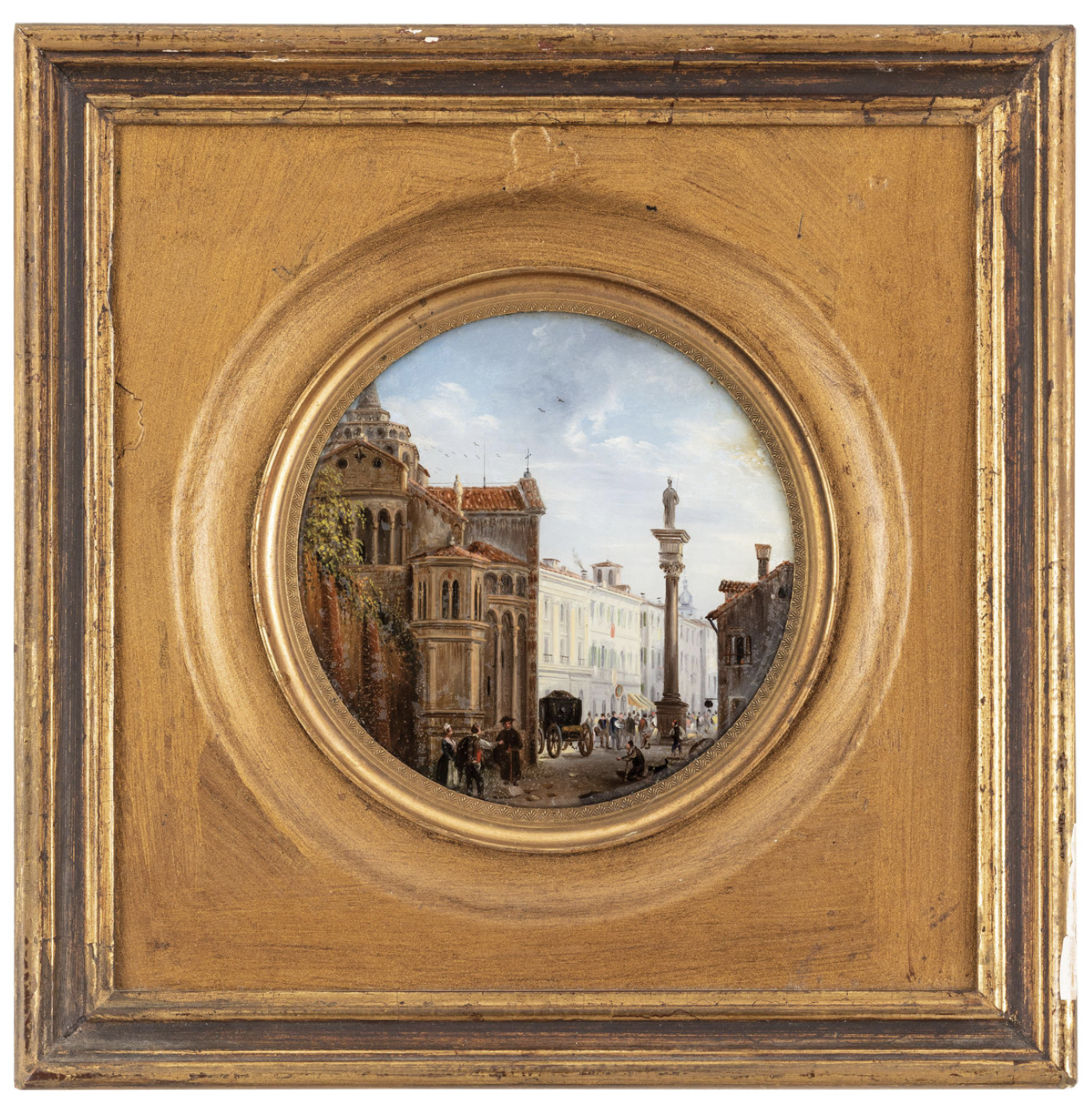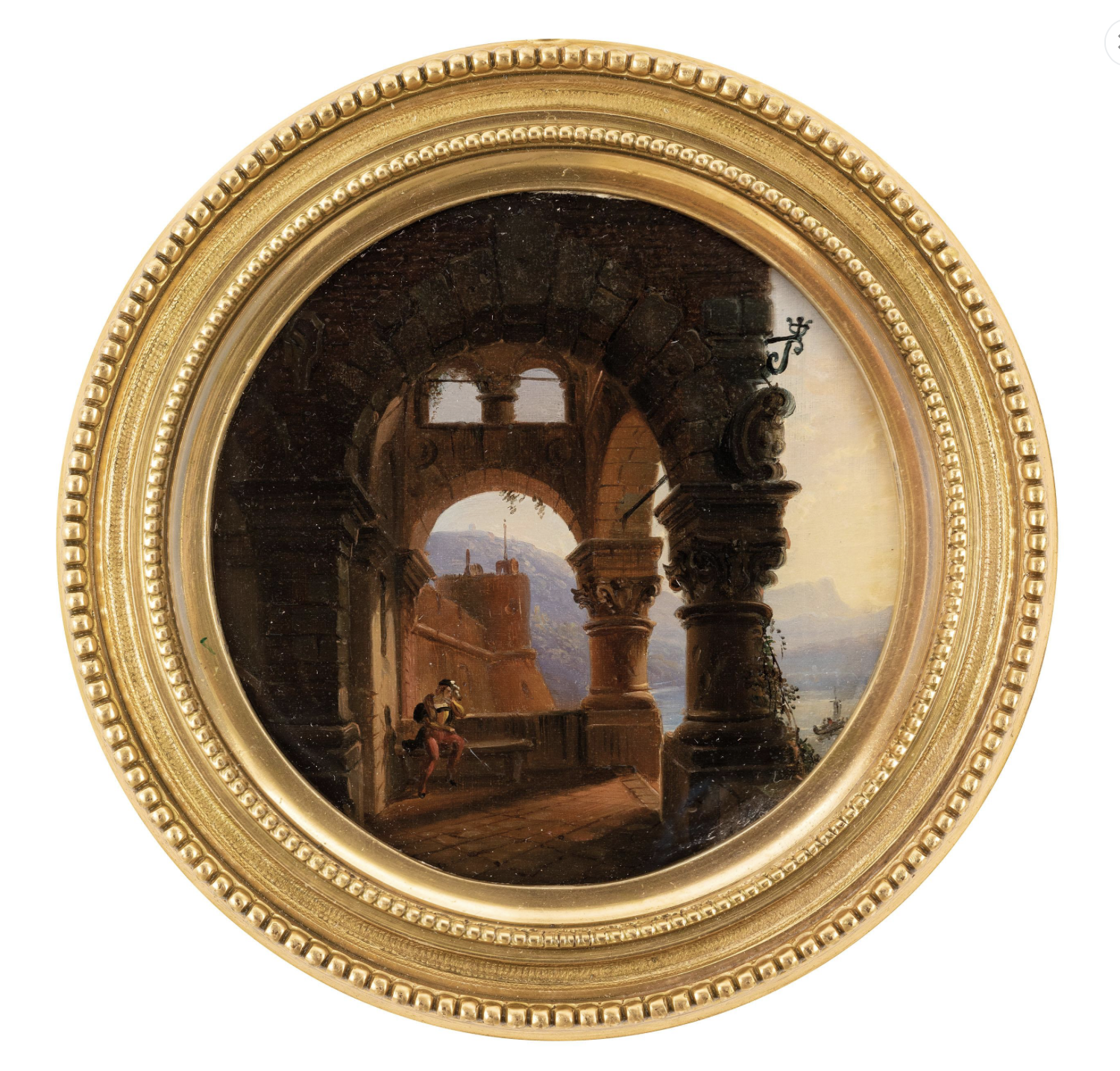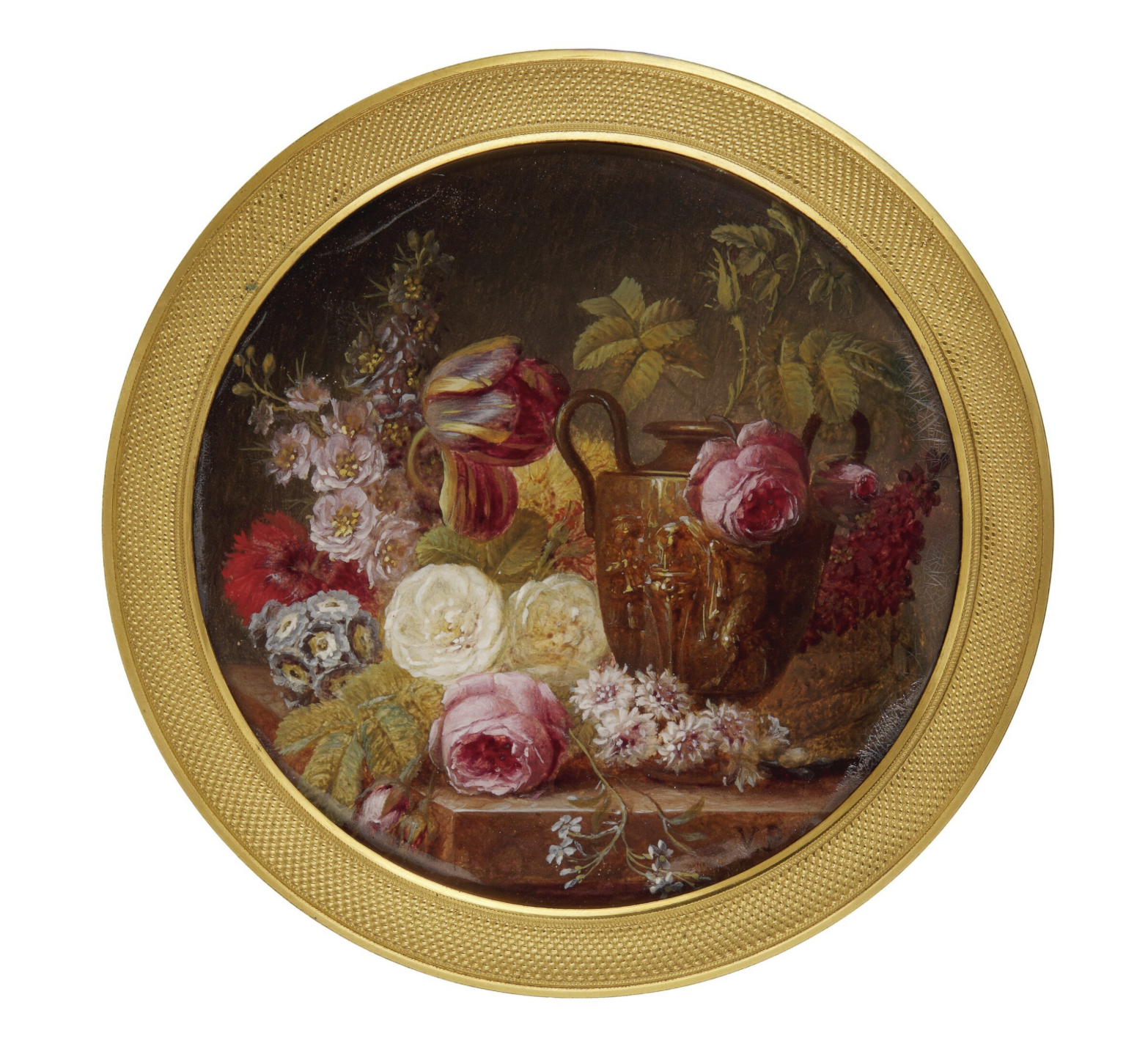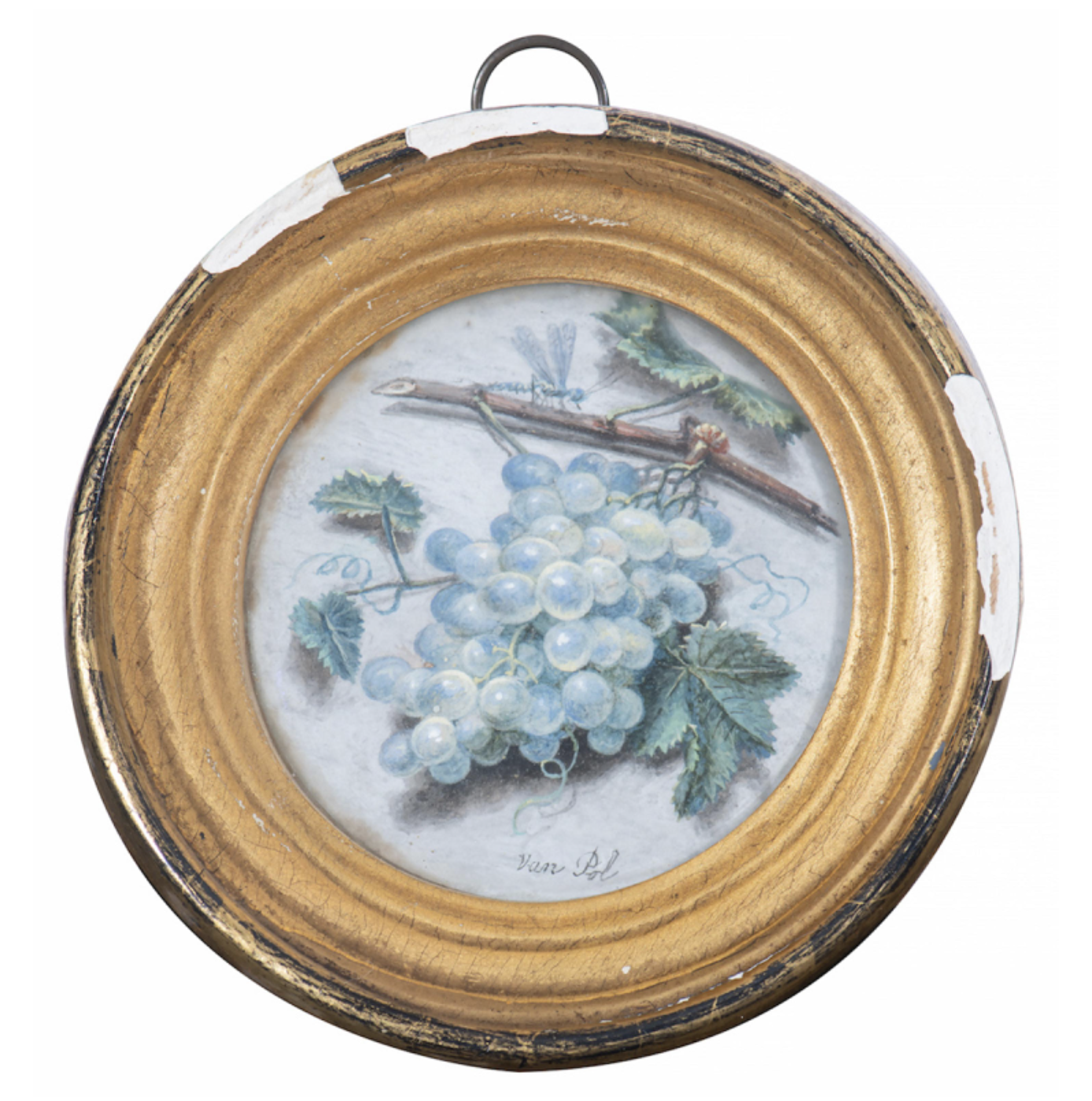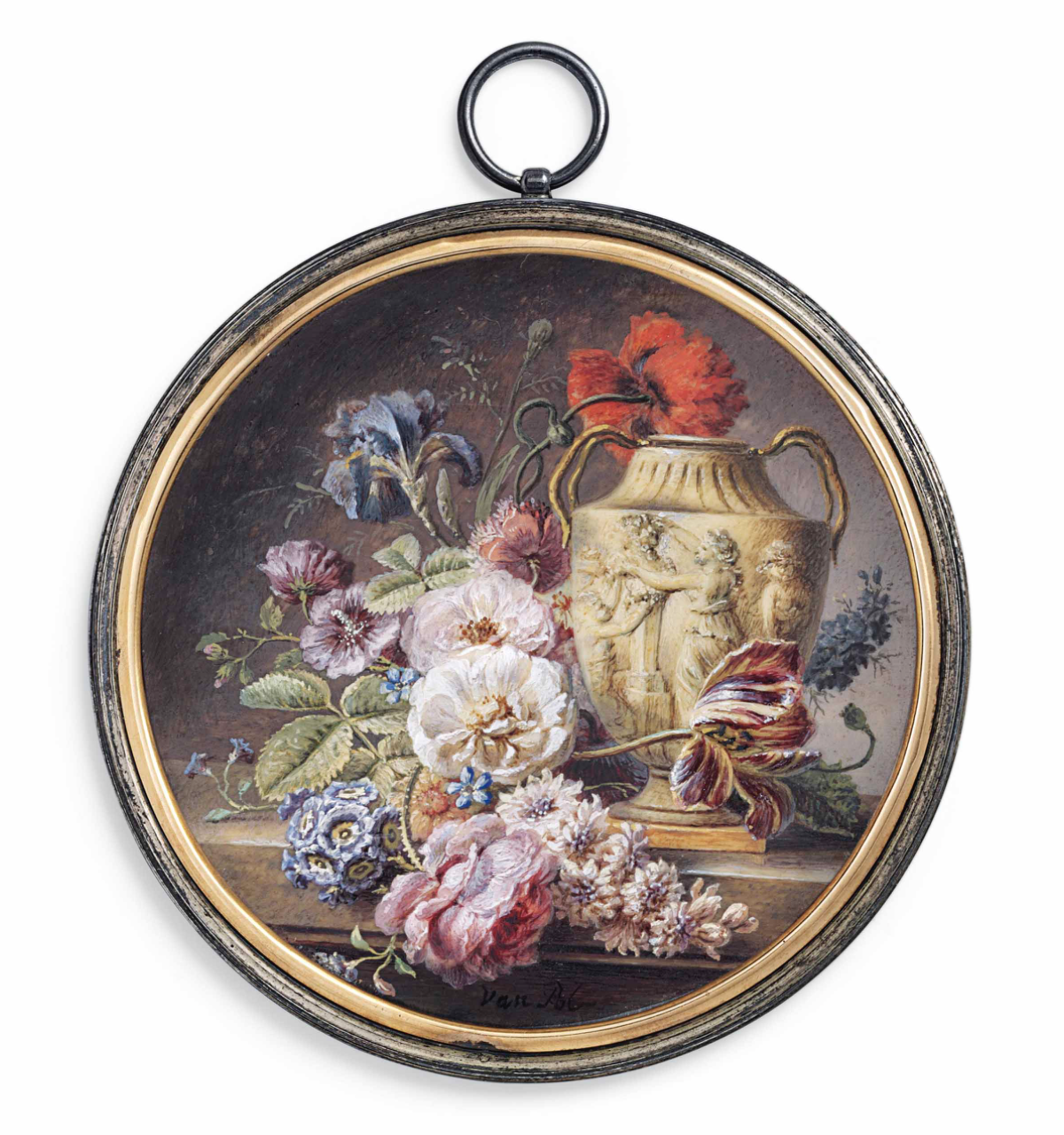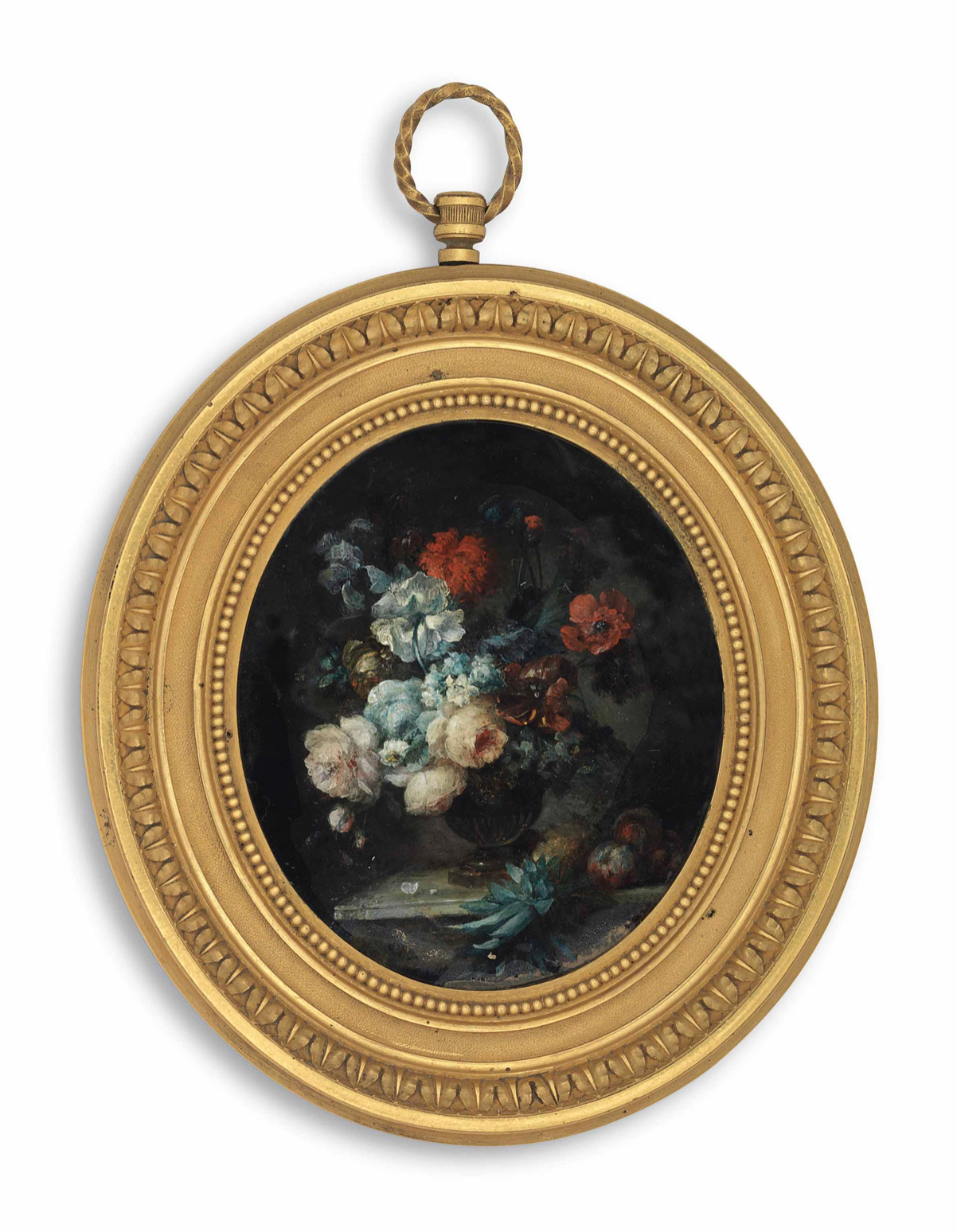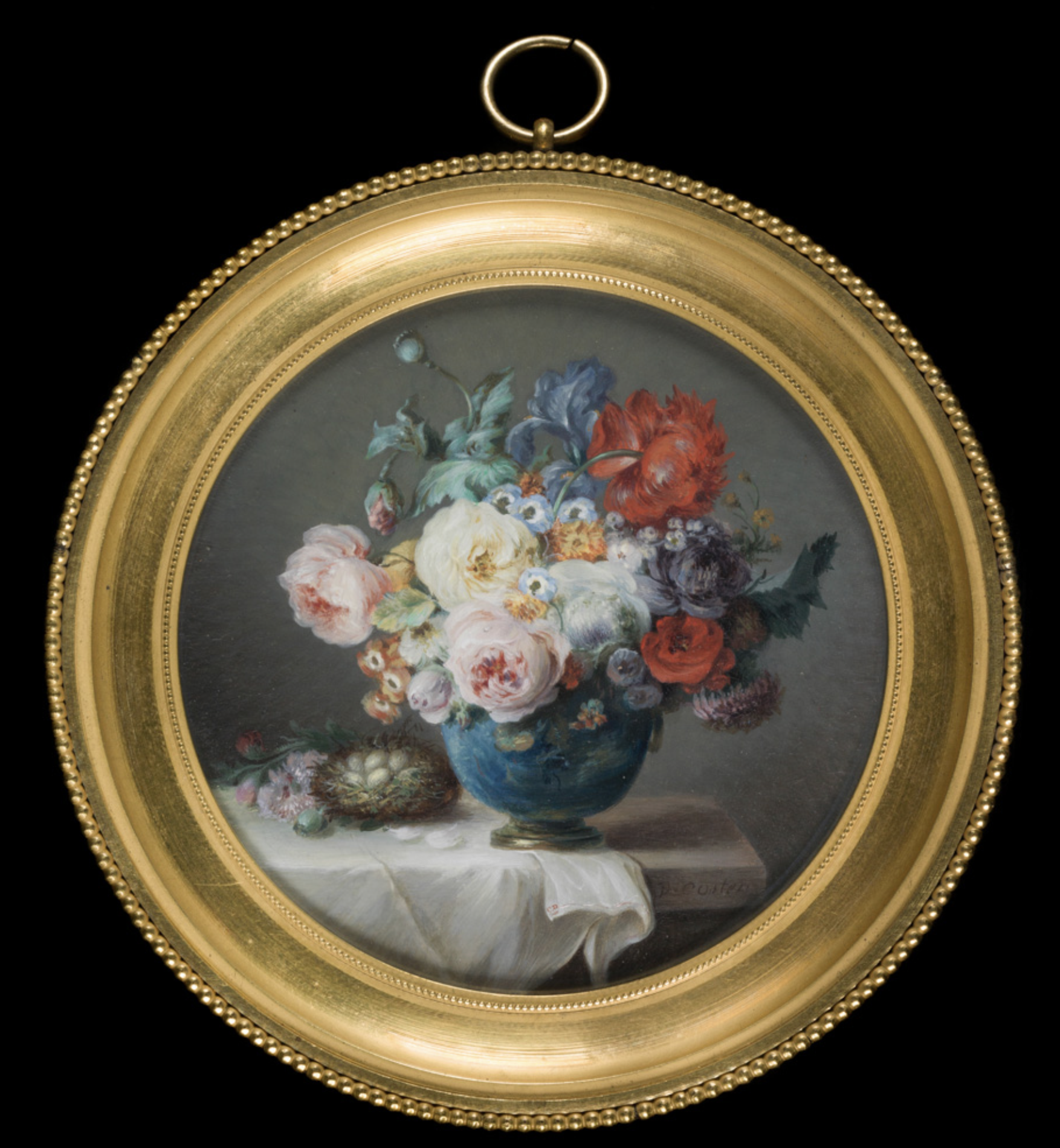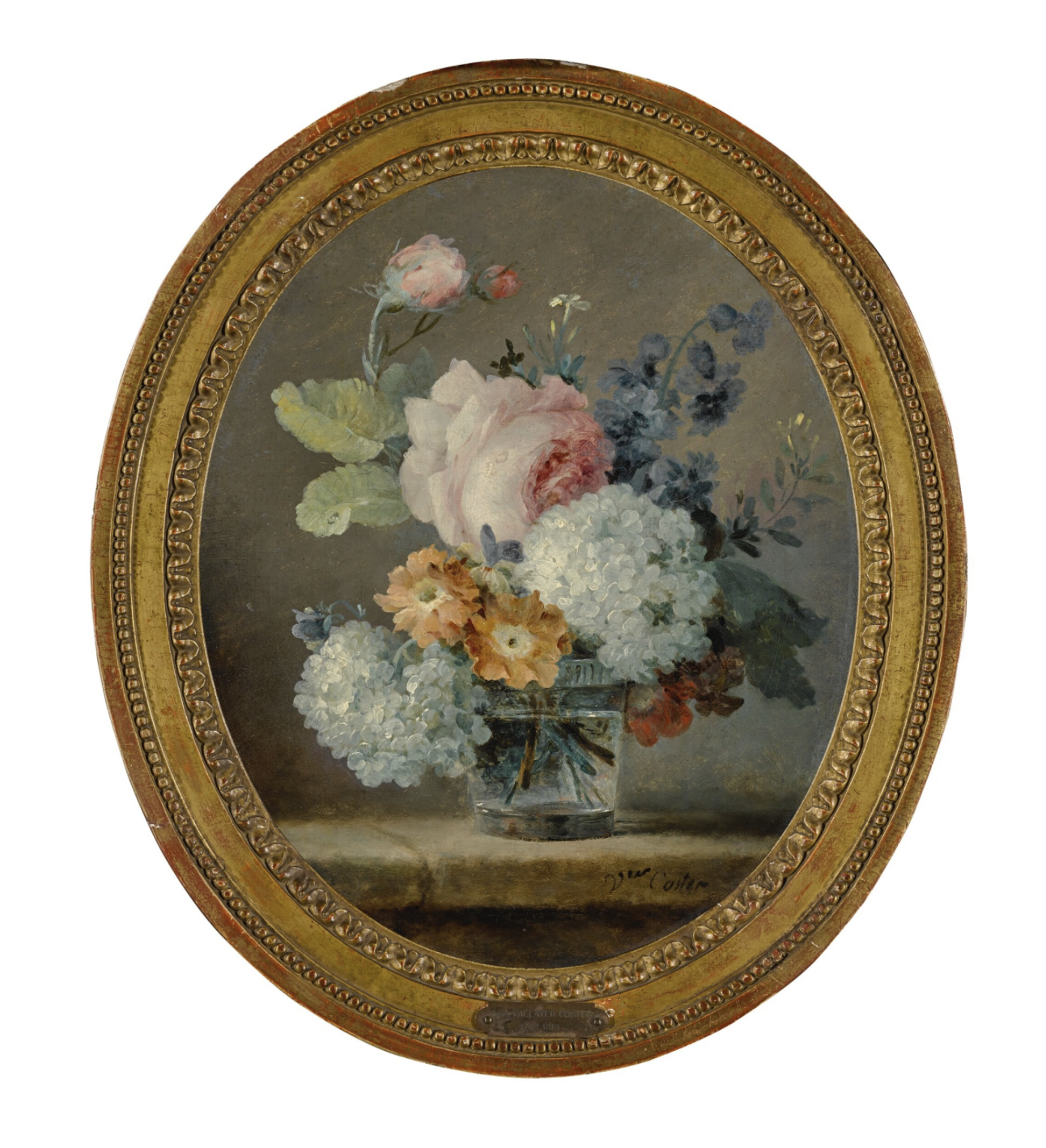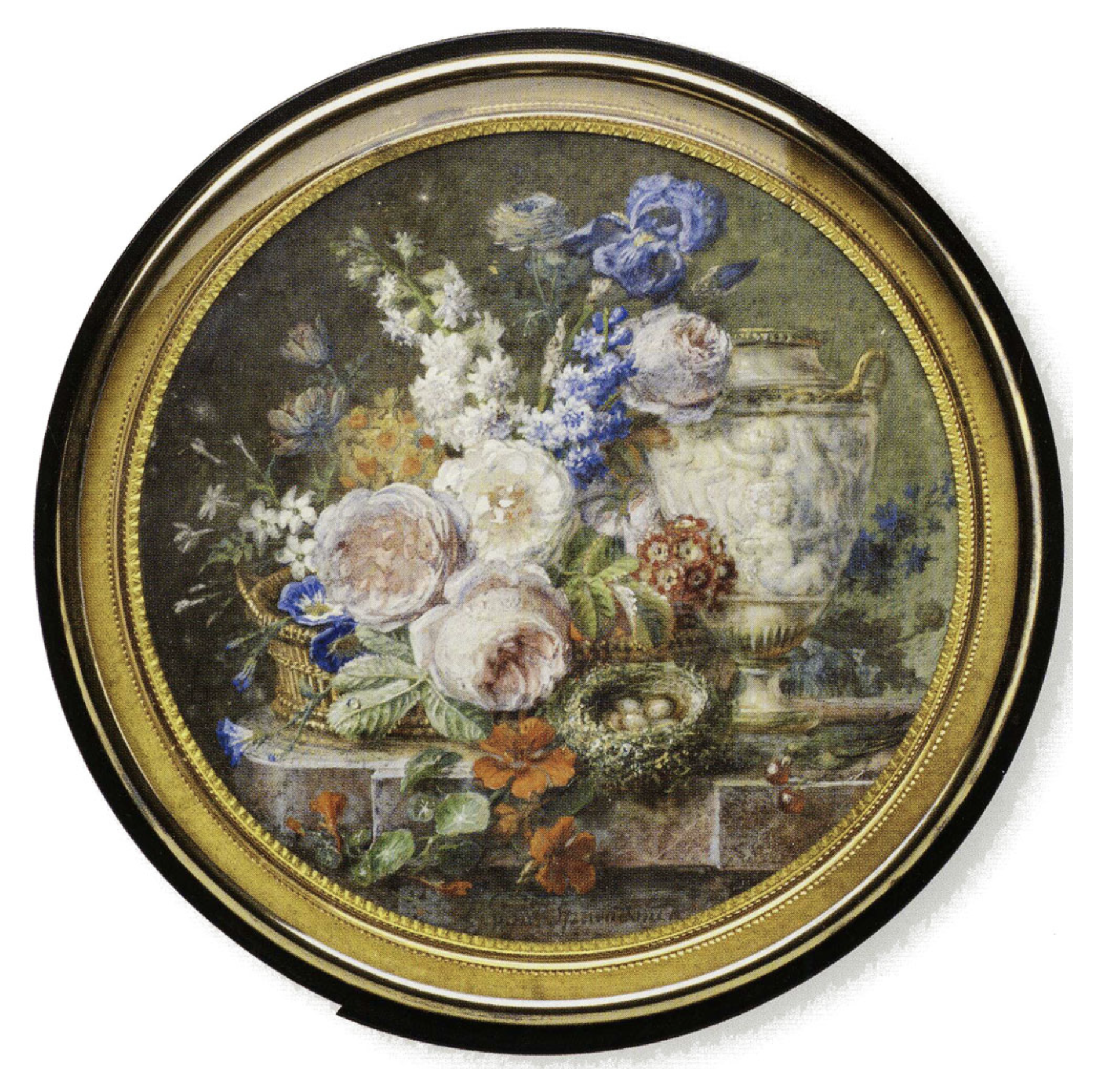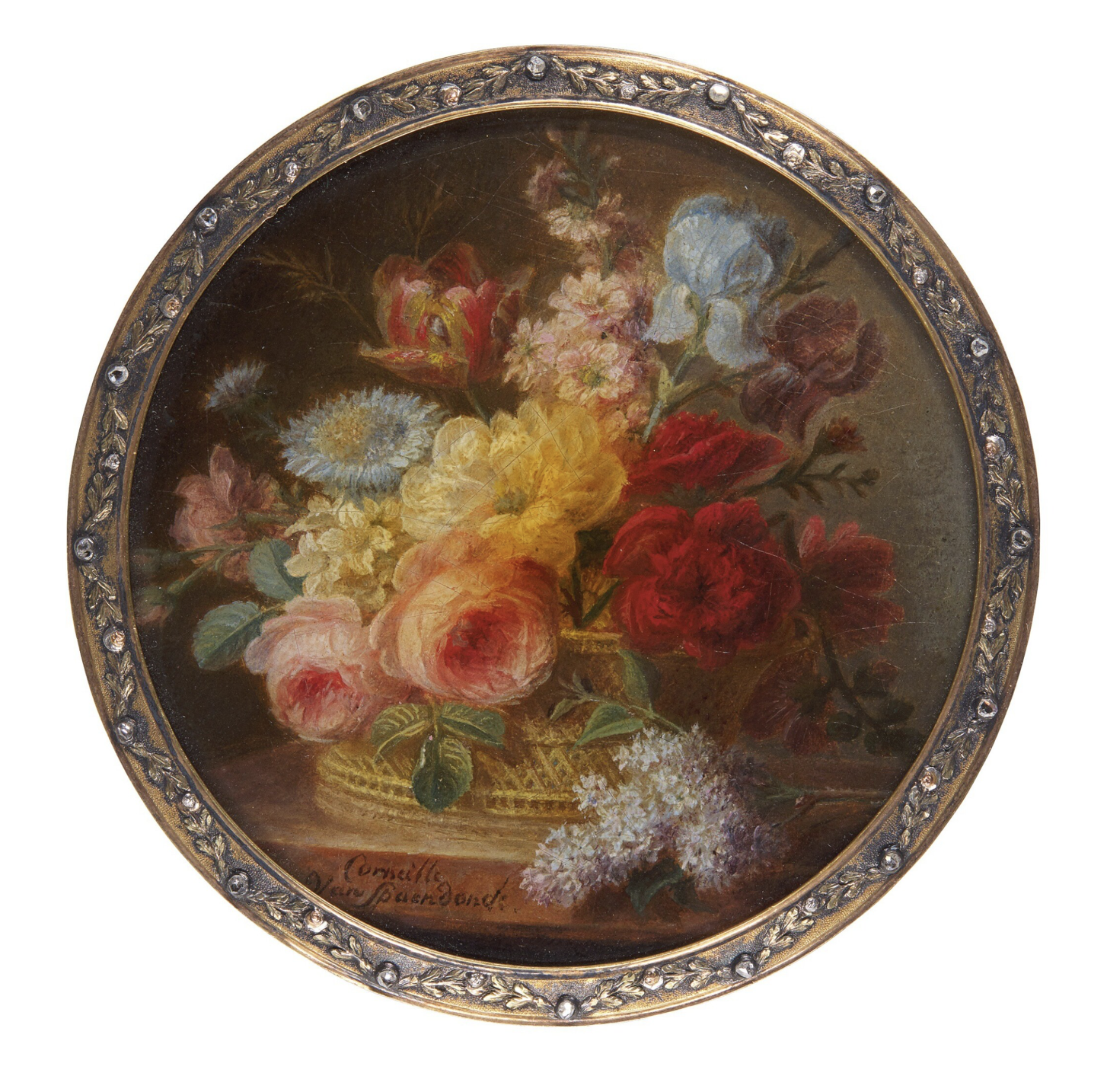The Inverted Miniature
Still-life and Landscape Miniatures
By Roxane Hemard | 9 April 2024
In the late 18th and 19th centuries in Europe, specifically Dutch and Flemish cities and France, miniature paintings depicting intricate arrangement of flowers, fruits, landscapes and seascapes had a surge in popularity. Although the specifics of who commissioned these portrait miniatures remain largely unknown, their significance was undeniable. These compositions, all rich in symbolism, conveyed themes of abundance, transience and the overall ephemeral beauty of nature, profoundly influenced by the 17th century Dutch tradition.
Fig 1. Unknown, Landscape, Fixé-sous-verre. The Limner Company
Still-Life
17th century Dutch still-life paintings, or Vanitas as they were often called, were symbolic works about the brevity of life and the vanity of worldly pursuits. Each object would have had a distinct iconographic symbolism with moralistic undertones. Despite being formalized as a distinct genre by the French Academy in the late 17th century, still-life painting occupied a lower rank in the hierarchy of artistic genres. The tradition of the subject matter continued to evolve through the Baroque and Rococo periods, with floral motifs permeating various forms of art and design, from paintings to curtains, furniture, and wallpaper. Among the first important publications on the subject is The Art of Painting by Claude Boutet (1739) which contains detailed instructions on how to paint draperies, flora and fauna, and most importantly, how to choose the best colours. [1]
By the late 18th century, still-life painting reached its zenith, with Gerard van Spaendonck (1746-1822) emerging as a leading figure in the genre. His influence spurred a new wave of painters and miniature painters from northern European countries and France.
Enamel in Germany
In Germany, the production of enamel in the miniature form was encouraged following the reign of Frederick the Great. In order to encourage local production, he introduced restrictions to the imports of French snuff boxes, which had become an increasingly popular import. The resulting growth of industry is reflected in the production of German porcelain factories like Messien (est. 1710), and Frankenthal (1755-1799). This pair of miniatures (figs 1 & 2) have certain stylistic elements, like the leaves, that are reminiscent of porcelain designs from the Frankenthal factory. The bright colours within the leaves and fruit in these still lives also reflect a wider development in the style of enamel in the 18th century. There could be messages behind these scenes; the bird depicted three times over the pair may be a European Goldfinch, a signifier of the Passion, often depicted next to symbols of vice, here represented by the glass of wine. Still-life paintings and miniatures also found new personifications, celebrating scientific achievements of the era. They frequently featured exotic fruits and medicinal plants reflecting the period’s growing interest in the classification of botanical specimens. [2]
Landscape
Parallel to still-lifes, miniatures of pastoral scenes, landscapes and seascapes provided artists with a canvas to showcase their skill in capturing the natural world on a diminutive scale. Despite their small size, they exuded a sense of grandeur and emotional intensity, encapsulating the sublime beauty of nature. The pastoral landscape had been a recurring motif in Dutch 17th century art, depicting a harmonious relationship between humans and nature or man and God’s bounty. [3] People were often portrayed enjoying a respite from labor amidst their picturesque surroundings, reflecting a peaceful coexistence between nature and man. [4]
The revival of these Dutch themes was profoundly influenced by the themes and style of the 19th century Romantic movement. Miniature portraits, previously characterized by an emphasis on power, dignity, and subjects of seriousness, now took on a new direction dominated by emotionality, imagination and a deep connection to nature. Seascape miniatures were particularly influenced by the Romantic period’s emotional themes, particularly the concept of the memento mori. This epoch's focus on the intensity of emotion, including the fear of death, was palpable in these miniature paintings. The personable aspect of a miniature in addition to these new subjects highlight the era’s preoccupation with human vulnerability and nature’s overpowering force. A pivotal motif of Romanticism was the portrayal of an ocean storm overwhelming egocentric man, [5] symbolizing nature’s untamable force over humanity. In this context, the divine was represented by the pure force of nature in paintings of landscapes.
Fixé-sous-verre
At the forefront of this artistic movement was the fixé-sous-verre technique. Also known as the “eludoric” method, this artistic approach has been practiced in the West since antiquity. The technique involves painting on the reverse side of a piece of glass, creating a distinctive mirror-like effect due to the reversed orientation of the artwork. Unlike traditional canvas painting or painting on vellum or ivory in miniature, where artists would typically begin with broad sketches, gradually adding details, the fixé-sous-verre painters start with the finer details and work their way towards the background. [6] This, as you can imagine, required meticulous planning, as artists must envision the entire composition from start to finish, taking into account the mirror effect that occurs during the painting process.
The technique was introduced in Venice during the Middle Ages, achieving full maturity by the Renaissance, largely due to the influence of Byzantine glassmakers on the island of Murano. These Murano glassmakers subsequently emigrated to other European cities in Italy, Austria, Germany, France and the Netherlands, spreading the fixe-sous-verre technique and adapting it to new themes and styles.
In the second half of the 18th century, Arnaud Vincent de Montpetit (1713-1800) refined the fixé-sous-verre technique, which involved creating oil paintings on fine cloth submerged in water. These paintings were then affixed to the back of an embossed glass using water-soluble glue, typically animal glue. By this point, numerous workshops drew inspiration from renowned painters like Francois Boucher, Chardin and Hubert Robert to decorate precious boxes using the fixe-sous-verre technique. These works were characterized by their meticulous craftsmanship and thematic richness, reflecting the influence of contemporary painting trends. Subjects also became bolder, not only of pastoral scenes but of still lives, landscapes or even more daring erotic scenes, seen on examples of snuff boxes. [7]
Let us now look at some of the most prominent figures in the art of painting still-life and landscape miniatures.
Giovanni Migliara (1785-1837)
Fig. 3 Classical Landscape with Diana and her entourage, circa 1810, Fixé-sous-verre, gilt-metal mount with Alphonse Giroux trade label. Sotheby’s, December 5, 2019, Lot 329
Fig. 4 Colleoni Chapel in Bergamo, circa 1825-1830, Fixé-sous-verre. Sotheby’s, September 20, 2022.
Fig. 5 Loggia sul Lago, Fixé-sous-verre. Invaluable
Fig. 6 A glimpse of a Milanese neighbourhood, now known as the ‘Verziere’, a named derived from the market that was held here between early 18th century and 1911. Fixé-sous-verre. Invaluable.
Italian painter Giovanni Migliara initially trained in Milan under Gaspare Galliari, master scenographer and designer of La Scala and Teatro Carcano, and painter of capricci (an architectural fantasy, placing together archeological ruins and other architectural elements in fictional and fantastical combinations). Migliari later specialised in landscape painting and yet never lost his interest in set design. He continuously pushed the limits of the Venetian Veduten tradition, Italian cross-pollination cityscape/landscape paintings inspired by 17th Century Dutch artists. Vedute were reminders of personal memories, like postcards of today, pioneered by Canaletto and Guardi in the 18th century. An increasing demand for memory views in the 19th century from the Venetian bourgeoisie encouraged artist such as Migliara to paint fantastic architectural as well as neoclassical landscape miniatures.
Christiaan van Pol (1752-1813)
Fig. 7 Still-life with flowers and an antique urn, circa 1805, fixe-sous-verre; signed lower right. Sotheby’s
Fig. 8 Still life with a bunch of grapes and a dragonfly; watercolour on paper (miniature) ; signed 'Van Pol' (lower centre). Invaluable
Fig. 9 A floral still-life with roses, parrot tulip, anemones, forget-me-nots, peonies, an iris, poppies, delphiniums, a classical vase, on a stone ledge, signed 'Van Pol' (lower right); on ivory. Sotheby’s.
Born in Berkenrode, Christiaan van Pol likely learned to draw in the tavern town known as Dorstige Kuil. It was here that he met fellow artists Simon Foke, John Greenwood, and Jan Punt, who were all associated with the Amsterdamse Tekenacademie (the practice school of draftsmanship). Pol’s formal training, however, began in Antwerp, where he specialised in “sieraad schilderen” or decorative painting. During his time in Antwerp, he met leading still-life painters of the time, Cornelis van Spaendonck, Gerard van Spaendonck and Jan Frans van Dael. Dael and Pol became close friends, traveling together to Paris in 1782 where they collaborated on creating decorative arabesques (for the Sorbonne and the castles of Bellevue, Chantilly, and Saint-Cloud) as well as painting miniature flower arrangements on snuffbox lids. In 1791, Pol even exhibited at the Salon where the incredible quality and richness of his compositions were admired.
As the Ancien Regime came to an end, Pol joined other Dutch painters specialising in still-lifes, aligning himself with the legacy of artists like Jan van Os and Spaendonck. Like them, he sought to revive the Golden Age of Dutch painting in Pairs, heavily inspired by the works of Jan van Huysum. See beautiful examples at the Fitzwilliam Museum, Cambridge.
Anne Vallayer-Coster (1744-1818)
”She astonishes us as much as she enchants us.”
– Diderot, 1771
Fig. 10 A still-life of flowers in an urn on a stone ledge with peaches and a pineapple; signed 'Coste[r]' (lower right); Fixé-sous-verre. Christie’s, 26 November 2014
Fig. 11 Bouquet of roses, poppies and carnations in a vase on a ledge, oil on paper laid on cardboard; signed lower right.
Fig. 12 Still Life of roses, snowballs, peonies and hyacinths in a glass on a ledge; signed lower right; oil on canvas. This painting was in the collection of miniaturist Louis Cournerie (1820-1891). Sotheby’s, 14 October 2020.
Born into an artistic family; her father being a master goldsmith and her mother painting miniatures, Anne Vallayer-Coster was known for her exceptional skills in still-life and portraiture. By the end of her life, she produced numerous miniatures (17 according to Marianne Roland Michel’s catalogue raisonné of the artist, 1970).
She received minimal training with botanical artist Madeleine Bassporte and in painting with landscapist Claude-Joseph Vernet. At only 26 years old, Vallayer-Coster was one of four women elected into the Academie Royale, where she continued to paint a broad range of subjects. [8] It wasn’t long until Queen Marie Antoinette named her Painter to the Queen in 1780, gifting her with her own quarters in the Louvre. Five years later, she received a scathing review for one of her portraits from critics at the Salon, deciding then to focus her attention entirely on still-lifes, exhibiting at the Salon until 1817. Luckily, she was able to escape the French Revolution unharmed, later even selling two flower paintings to Empress Josephine in 1804. [9]
Intricately detailed, her miniatures showcase both her technical power and artistic sensibility. Often featuring floral arrangements, luxurious objects and sumptuous fruits, she was able to capture the gorgeous textures of her larger still life paintings on a much smaller scale. Her innate skill at painting with verisimilitude the soft skin of a peach, the delicacy of a flower’s petals and the glittering surfaces of gold and bronze is truly astounding, marking her as one of the most impressive still-life painters and miniaturists in history.
Gerard van Spaendonck (1746-1822)
Fig. 13 Tortoiseshell Box with Miniature of a Still life with Flowers; circa 1775-1800; tortoiseshell, gouache. Noordbrabants Museum, 's-Hertogenbosch.
Fig. 14 A gold-mounted miniature of a still life painted on ivory, Gerard van Spaendonck, Paris, circa 1785. Sotheby’s 26 May, 2021, Lot 46.
Fig. 15 Cornelis van Spaendonck (1756-1840). Still Life with a basket of flowers, circa 1805, Fixé-sous-verre, two colour gold mount, set with diamonds; signed lower left. Sotheby’s, 5 December 2019.
Gerard van Spaendonck is no doubt the most famous still-life miniaturist working in the 18th century. The older brother of Corenelis van Spaendonck, (Fig.15), an accomplished artist in his own right, he began his training with decorative painter Willem Jacob Herreyns in Antwerp. Shortly after his arrival to Paris from Flanders in 1769, Spaendonck attracted prestigious commissions from the newly crowned French monarch and his brother, the Comte d’Artois, appointed miniature painter to Louis XVI a mere five years later.
In 1780, he became an official member of the Academie des Beaux-Arts where he mentored future botanical pioneers Pierre-Joseph Redoute (1759-1840) and Henriette Vincent (1786-1834). A loved professor, devoted scholar and popular painter, he was awarded the Legion d’Honneur by Napoleon Bonaparte in 1804.
Spaendonck’s extensive book on botanicals Fleurs Dessinees d’Apres Nature (1801) comprises numerous engravings for students of floral painting, and has become one of the most treasured books on floral art to this day. This careful study of botanicals is evident in Spaendonck’s still-life paintings. The finesse of Spaendonck’s brushwork is even more evident in his miniatures, where his striking textural contrasts and brilliance of colours are beautifully displayed.
[1] The art of painting in miniature : teaching the speedy and perfect acquisition of that art without a master : by rules so easy, and in method so natural as to render this charming accomplishment universally attainable ... translated from the original French. Claude Boutet, 35.
[2] Miniature Painting in Eighteenth-Century England: The Case of William Pether (1739–1821)
[3] 19th Century Miniature Landscape and Seascapes - Kathleen C. Paul 2017
[4] Dutch painters began to produce a new view, one of the here and now – the world as experienced by real people. Painting in the Dutch Golden Age, National Gallery of Art, 2007
[5] 19th Century Miniature Landscape and Seascapes - Kathleen C. Paul 2017
[6] Le fixé sous verre: l’art de la peinture inversée, La Magazine de Proantic, 2014
[7] Bonhams, London, 21 November 2012, lot 25.
[8] Some have suggested Alexander Roslin, Swedish painter who worked for aristocratic families supported her candidacy and facilitated her introduction to Marie Antoinette. Anne Vallayer-Coster, Portrait of a Violinist, Art Bulletin of Nationalmuseum, Stockholm. See Roslin’s portrait of Anna Vallayer-Coster at Crocker Art Museum, 2016.50
[9] A still life by Anne Vallayer-Coster that was lost to scholars for two centuries: ‘The work she considered her finest’, Christie’s, 2023


